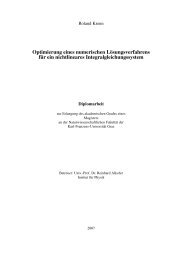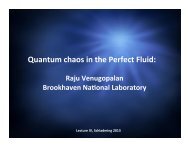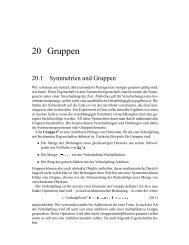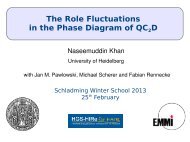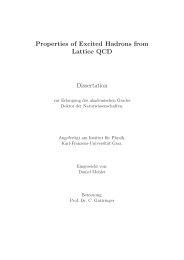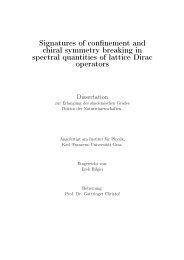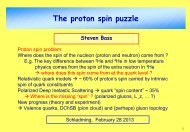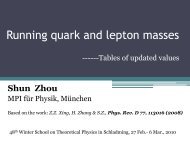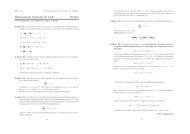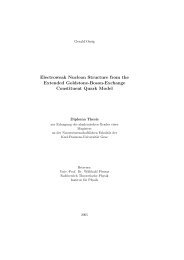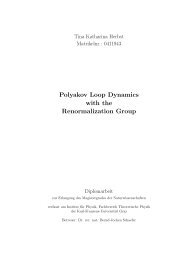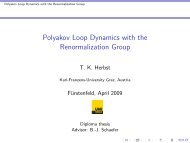The QCD Quark Propagator in Coulomb Gauge and - Institut für Physik
The QCD Quark Propagator in Coulomb Gauge and - Institut für Physik
The QCD Quark Propagator in Coulomb Gauge and - Institut für Physik
You also want an ePaper? Increase the reach of your titles
YUMPU automatically turns print PDFs into web optimized ePapers that Google loves.
Chapter 6. Nucleon Form Factors <strong>in</strong> a Covariant Diquark-<strong>Quark</strong> model 85<br />
1.2<br />
1<br />
/ G M<br />
p<br />
µ p<br />
G E<br />
p<br />
0.8<br />
0.6<br />
0.4<br />
0.2<br />
set A<br />
set B<br />
SLAC<br />
JLab 1<br />
JLab 2<br />
0<br />
0 1 2 3 4 5 6<br />
Q 2 [GeV 2 ]<br />
Figure 6.5: Proton form factor ratio µ p G p E (Q2 )/G p M (Q2 ), [AHK + 05]. Calculated results:<br />
lower b<strong>and</strong> - set A <strong>in</strong> table 6.1; <strong>and</strong> upper b<strong>and</strong> - set B. For both b<strong>and</strong>s, G p E (Q2 ) was<br />
calculated us<strong>in</strong>g the po<strong>in</strong>t-particle values: µ 1 + = 2 <strong>and</strong> χ 1 + = 1, equation(6.77), <strong>and</strong> κ T = 2,<br />
equation(6.83); i.e., the reference values <strong>in</strong> tables 6.2–6.4. Variations <strong>in</strong> the axial-vector<br />
diquark parameters used to evaluate G p E (Q2 ) have little effect on the plotted results. <strong>The</strong><br />
width of the b<strong>and</strong>s reflects the variation <strong>in</strong> G p M (Q2 ) with axial-vector diquark parameters <strong>and</strong>,<br />
<strong>in</strong> both cases, the upper border is obta<strong>in</strong>ed with µ 1 + = 3, χ 1 + = 1 <strong>and</strong> κ T = 2, while the<br />
lower has µ 1 + = 1. <strong>The</strong> data are: squares - reference[J + 00]; diamonds - reference[G + 02]; <strong>and</strong><br />
circles - reference[W + 94].<br />
G + 02]. It should be stressed that neither this nor the Rosenbluth [W + 94] data played any<br />
role <strong>in</strong> the preced<strong>in</strong>g analysis or discussion.<br />
<strong>The</strong> extension of the calculation for set B to higher momenta is displays <strong>in</strong> figure 6.6.<br />
<strong>The</strong> form factor ration passes through zero at Q 2 ≈ 6.5GeV 2 . This prediction still awaits<br />
an experimental test. In our model the existence of the zero is robust but its location<br />
depends on the model’s parameters.<br />
We have also exam<strong>in</strong>ed the proton’s Dirac <strong>and</strong> Pauli form factors <strong>in</strong> isolation. On<br />
the doma<strong>in</strong> covered, neither F 1 (Q 2 ) nor F 2 (Q 2 ) show any sign they have achieved the<br />
asymptotic behaviour anticipated from perturbative <strong>QCD</strong>.<br />
In figure6.7 we depict weighted ratios of these form factors. Our numerical results are



